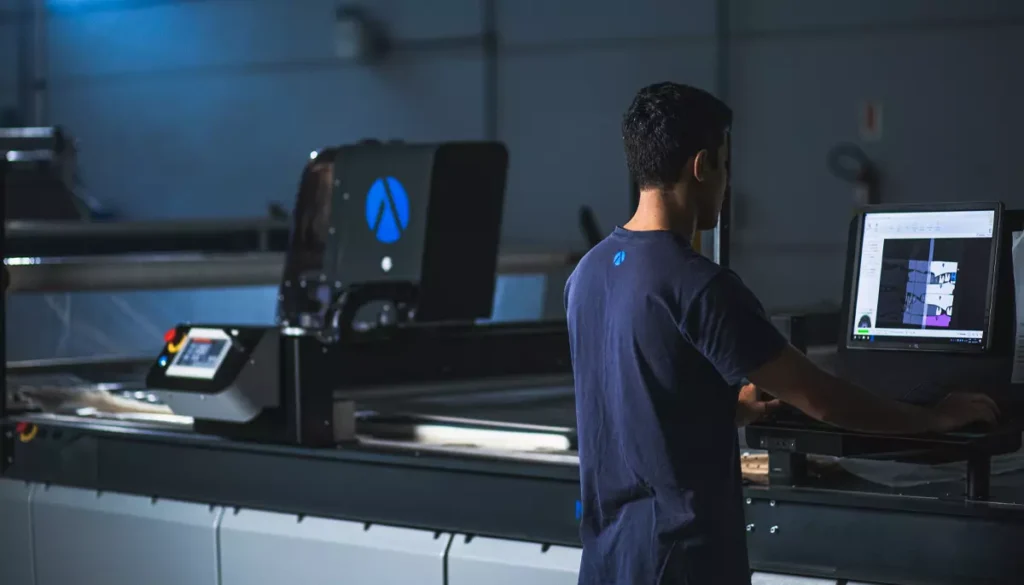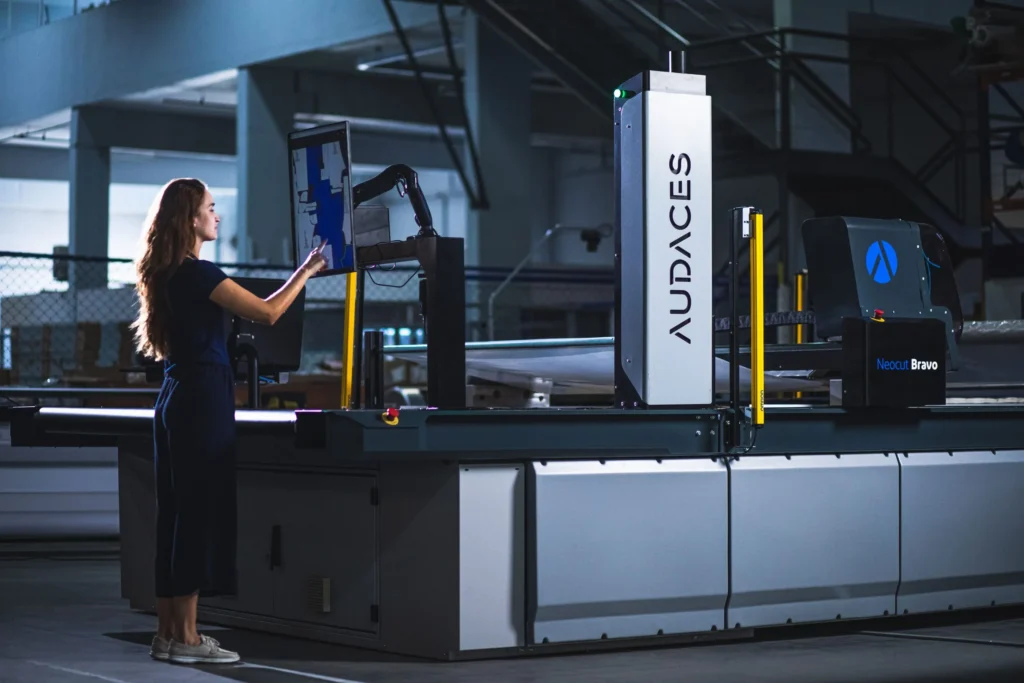Summary
- The act of manipulate fabric stands as the first step of fashion manufacturing.
- Carefully performing this process preserves the quality of the raw material.
- Technology is here to enhance your production efficiency. Try Audaces360 for free now!
Fashion industry professionals understand the significant impact of raw material costs on final product pricing. Therefore, it is necessary to manipulate fabric in the best possible way to gain agility in production.
In a competitive landscape, reducing waste throughout the process is paramount. To address this challenge, fashion companies need to invest in innovation to maintain high profits.
If you want to learn more about how to use fabric better and how technology can help, check out our detailed guide. It covers the potential benefits, tips, and a list of equipment to start to manipulate fabric automatically.
Enjoy your reading!
Sumário
What is the importance of proper fabric manipulation in apparel manufacturing?
Different types of fabric manipulation ensure waste reduction and the quality of the finished product.
It starts with spreading, where fabric layers are precisely aligned to prepare for a flawless cut. Careful edge alignment guarantees smooth fabric operation, removing folds or flaws that could ruin the final garment.
During the cutting stage, accuracy is key to successfully manipulating fabric. With innovative solutions, it is possible to achieve zero space between pattern pieces, resulting in a perfect cut. Precise and waste-free cutting ensures the use of all fabric, making production more cost-effective.
Additionally, automated systems can significantly enhance these processes, providing increased precision, speed, and efficiency.
By adopting advanced technologies, businesses can optimize fabric usage, reduce errors, and ultimately deliver higher-quality products to market.
Learn more: Learn more about fabric yield and avoid waste in your production
What is fabric manipulation?
Textile manipulation is the process that encompasses preparing and handling fabric before it’s cut for garment production.
It encompasses a series of steps aimed at ensuring the fabric is ready for the next stage of manufacturing.
By effectively manipulating fabric, companies can improve production efficiency. Consequently, this reduces costs and enhances the overall quality of the final product.
Key steps in fabric manipulation include spreading, cutting, and handling. Each of these stages requires precision and care to optimize fabric usage and minimize waste.
6 benefits of automating fabric manipulation
These are the main advantages your company will gain from automating the way they manipulate fabric:
1) Increased productivity
Embracing technology when you manipulate fabric can significantly speed up your workflow. This leads to higher production output and quicker turnaround times, meeting increased market demands with efficiency.
In addition, automation reduces idle time and minimizes bottlenecks in the production process, further enhancing overall productivity.
By optimizing labor use and streamlining operations, businesses can increase their production capacity. This leads to improved efficiency and enables companies to compete more effectively in fast-paced markets.
Learn more: 4 ways to overcome slow cutting in your apparel manufacturing
2) Cutting precision
Automated cutting machines are highly effective at making precise cuts, which reduces fabric waste and ensures consistency.
It leads to higher-quality garments and lower material costs. Moreover, these machines can manage intricate patterns and complex shapes, allowing for greater creative freedom for fashion designers.
This opens a world of possibilities for experimenting with new ideas, creating authentic designs, and standing out from competitors in the market.
Learn more: How to obtain quality and precision in the cutting fabric process?
3) Enhanced quality
Automation eliminates human error, leading to improved fabric handling and reduced defects. Consistent fabric manipulation processes result in higher-quality end products, enhancing brand reputation.
Furthermore, automated systems can maintain precise control over fabric tension and alignment, preventing distortions and ensuring dimensional stability in the final garment.
This contributes to a more polished and professional appearance, adding value to the product and enabling higher profit margins.
If you are planning to enhance your company’s quality and productivity through automation, fill out the form below and receive a personalized project from our experts!
4) Automatic marking
Automatic marking streamlines repetitive tasks, such as rotating and positioning patterns. It frees up time for professionals to focus on more strategic activities.
It has a great impact on production efficiency, as cutting times are also optimized. Additionally, automatic marking allows for quick testing of different setups.
This lets pattern makers calculate the fabric consumption before committing to a final version, reducing waste and improving material usage. By automating these time-consuming tasks, businesses can allocate resources more effectively, enhance productivity, and achieve greater profits.
Learn more: 4 reasons to create automatic marker on the computer
5) Compaction and inflation of layers
Automated systems can precisely control the compaction and inflation of fabric layers during spreading. This ensures uniform fabric thickness, preventing issues like puckering or distortion in the final garment.
Automated systems can also optimize fabric use by minimizing air gaps between layers, reducing waste, and maximizing material efficiency.
This level of control contributes to improved garment quality and increased production throughput.
6) Fabric flaw detection
Advanced sensors in automated equipment can identify fabric defects such as holes, or other problems during the manipulation process.
This technology prevents defective materials from entering the production line, saving time and resources.
Detecting flaws early in the process allows businesses to avoid costly rework, as they often go unnoticed until the sewing stage. This wastes time for seamstresses and leaves garments incomplete.
Therefore, automated fabric flaw detection ensures the delivery of high-quality products to customers.
What equipment is necessary for fabric manipulation?

To take the first step to manipulate fabric automatically in your garment manufacturing, check out the list of equipment we’ve prepared:
Cutting machine
This machine is the heart of any cutting room. Therefore, it’s essential to make an informed investment.
Automated equipment enables you to maximize your production capacity. It streamlines the process and saves employees time. Instead of manual cutting, prone to human error, employees operate the machinery. This allows them to focus on product quality.
The integrated management software facilitates efficient production planning. This accelerates deliveries and ensures machines are always in use, leading to a quick return on investment.
Learn more: 6 benefits of automatic cutting for your fashion business
Automatic spreader
This innovative machine empowers you to program multiple fabric spreads, in the sequence required for your production.
It brings autonomy and dynamism to the operation, as employees no longer need to manually plan this process.
Automated spreader machines also ensure even fabric tension and edges, guaranteeing consistent quality in every fabric layer.
Learn more: Discover what automatic fabric spreading is and how to make it properly
Cutting table
A cutting table provides a flat, stable surface for spreading and cutting fabric. A good table must adapt to various spread sizes to be able to maximize your production capacity.
Additional essential features include support for your spreading machine and ease of cleaning. This is because, after each spreading, a layer of dust from fabrics of different colors inevitably accumulates.
Invest in a sturdy cutting table made from durable materials, ensuring years of reliable service in your garment manufacturing.
Learn more: Why invest in a good fabric cutting table for garment production?
Cutting management software
This kind of software streamlines production planning and management by providing a digital platform for all stakeholders, updating information in real time.
Managers can effortlessly schedule cut orders, specifying details like spreads, layers, cuts, and fabric quantities.
The system monitors progress and alerts you to any discrepancies between planned and completed tasks. It also provides suggestions for resolving these issues as quickly as possible to avoid any production bottlenecks.
Harness the power of technology to manipulate fabric in your manufacturing

By embracing cutting-edge technology, apparel manufacturers can achieve significant improvements in the production process. From greater design flexibility to enhanced efficiency and reduced costs.
Audaces Cutting Room
Our experts will thoroughly assess your company’s needs and create a customized Audaces Cutting Room project.
This way you can leverage the power of Audaces’ cutting-edge software and machinery to automate your production process.
Achieve impeccable cuts on curves and details, speeding up your deliveries and minimizing fabric waste through automation.
Partner with a company boasting over 30 years of textile industry expertise, ensuring an exceptional return on investment!
Click here to request your personalized project.
FAQ
Proper fabric manipulation ensures waste reduction and the quality of the finished product.
Fabric manipulation is the processes that encompass preparing and handling fabric before it’s cut for garment production.
Increased productivity, cutting precision, enhanced quality, automatic marking, compaction and inflation of layers, and fabric flaw detection.










